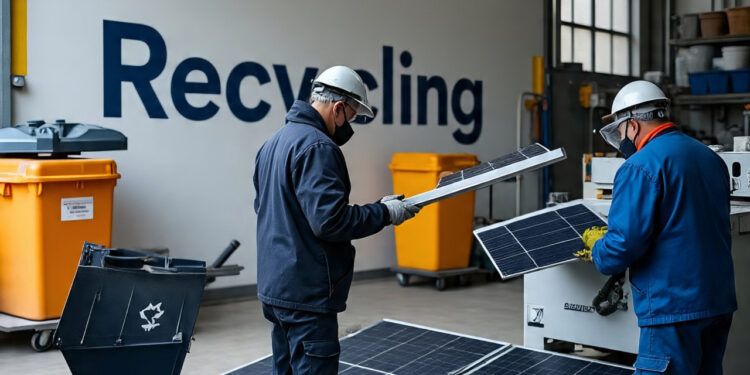As solar technology continues to grow across communities, the conversation is shifting beyond just installation and efficiency to what happens at the end of a panel’s life. Solar panels are built to last around 25 to 30 years, but once they reach that limit, they must be managed responsibly. Simply discarding them in landfills can waste valuable materials and potentially harm the environment. That is why solar providers have been increasingly focused on recycling processes that capture value and reduce environmental risks. We will explore how solar providers address this challenge, the methods they employ for panel recycling, and the benefits these practices offer to both consumers and the environment.
The Methods Solar Providers Use to Recycle Solar Panels
-
Collection and Transportation Systems
The first step solar providers take in recycling panels involves organized collection and transportation. When panels are removed from rooftops or ground-mounted arrays, they cannot simply be piled up and ignored. Companies like North Valley Solar Power often partner with recycling facilities or manage their own logistics to ensure panels reach proper processing centers. This step is crucial because panels contain glass, silicon, and trace amounts of metals like silver and lead, which can become hazardous if improperly disposed of.
Providers work to streamline collection by coordinating with local waste management agencies, offering pickup services, or arranging bulk shipments from large solar farms. This ensures that solar panels do not end up in general waste streams. The transportation process is carefully managed to prevent breakage, which can complicate the recycling process. By investing in proper collection infrastructure, solar providers establish the foundation for an efficient recycling cycle that begins as soon as a panel is retired.
-
Mechanical Recycling Techniques
Once panels are delivered to recycling centers, the most common method of processing is mechanical recycling. This technique involves physically breaking down the solar panels into their base components. Providers coordinate with facilities that utilize shredders, grinders, and separation machines to extract glass, aluminum, and plastics. Glass often constitutes the largest percentage of a solar panel, and it can be repurposed for new construction materials or even for new panel production. Aluminum frames are removed and melted down for reuse in various industries.
Plastics and wiring are separated and processed for secondary applications. While mechanical recycling does not always recover the highest purity of silicon or metals, it is still effective for handling large volumes of panels. Providers prefer this method because it is relatively cost-efficient and widely available, allowing them to address recycling needs on a broad scale.
-
Chemical and Thermal Recovery Methods
Mechanical recycling is effective, but it sometimes leaves behind valuable materials such as silicon and trace metals. To address this, solar providers also turn to chemical and thermal recovery methods. These processes are more advanced and involve using heat or chemical solutions to separate silicon wafers and recover precious metals. For example, panels can be heated to loosen the binding materials, making it easier to extract high-quality silicon that can be reused in new photovoltaic cells. Chemical baths can dissolve certain layers of the panel, allowing providers to reclaim silver or copper with greater efficiency.
These methods are more resource-intensive, but they deliver higher-value recoveries, which can make recycling more financially sustainable. Providers often collaborate with research labs or advanced recycling companies to ensure these methods are applied in situations where high-value recovery is feasible. This dual approach—mechanical for volume and chemical for precision—gives providers flexibility in managing recycling responsibly.
-
Partnerships with Recycling Networks and Manufacturers
Another important way solar providers deal with recycling is by forming partnerships with recycling networks and manufacturers. Providers often lack the capacity to handle recycling entirely on their own, so they collaborate with established networks that specialize in material recovery. Some providers establish take-back programs in collaboration with manufacturers, ensuring that panels at the end of their life cycle are returned to the original producers for responsible disposal. These partnerships create circular supply chains, allowing recovered materials to be reintegrated into new panel production.
In regions with strong regulatory requirements, providers also align with government-approved recycling programs to meet compliance standards. By forming these partnerships, providers not only reduce their environmental footprint but also create opportunities for innovation in panel design. This collaboration encourages manufacturers to design panels that are easier to recycle in the future, creating long-term benefits for the entire solar industry.
Solar panel recycling is no longer a distant consideration—it is a present reality that solar providers are addressing with careful planning and action. By creating collection systems, applying mechanical and chemical recovery methods, forming partnerships, educating consumers, and investing in future innovations, providers are building a responsible framework for end-of-life panel management. As adoption grows, recycling will become a defining feature of the industry, ensuring solar power delivers long-term value without shifting the burden onto future generations. Solar providers are demonstrating that renewable energy does not end with installation—it continues through sustainable recycling practices that complete the cycle of clean power.







